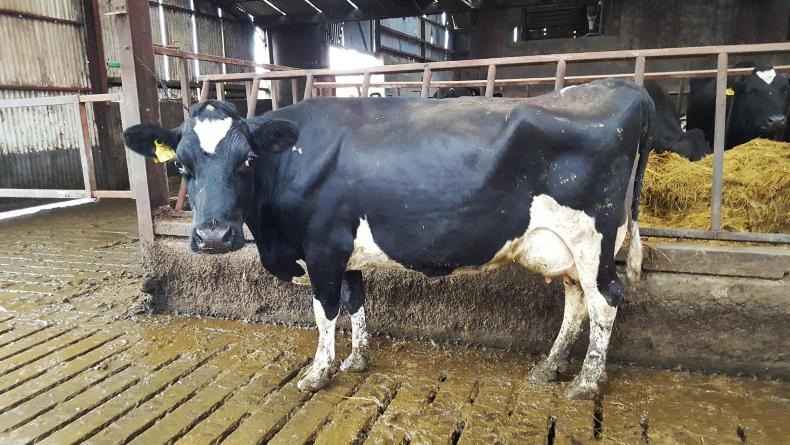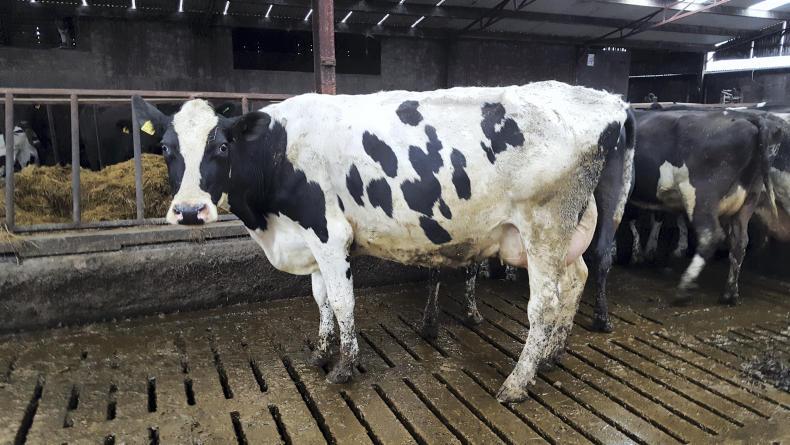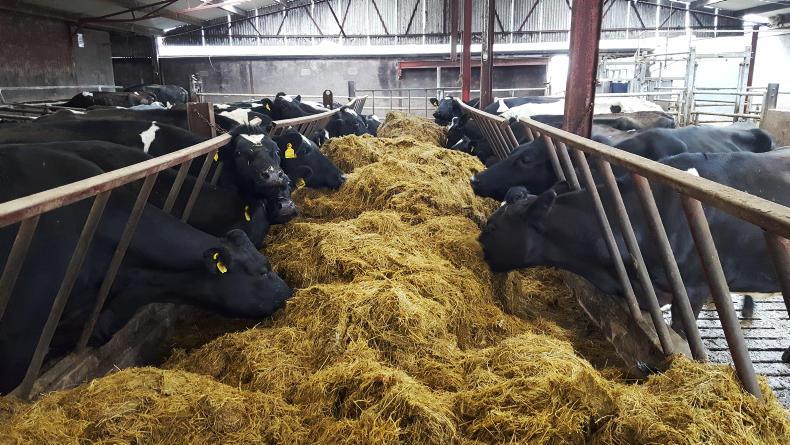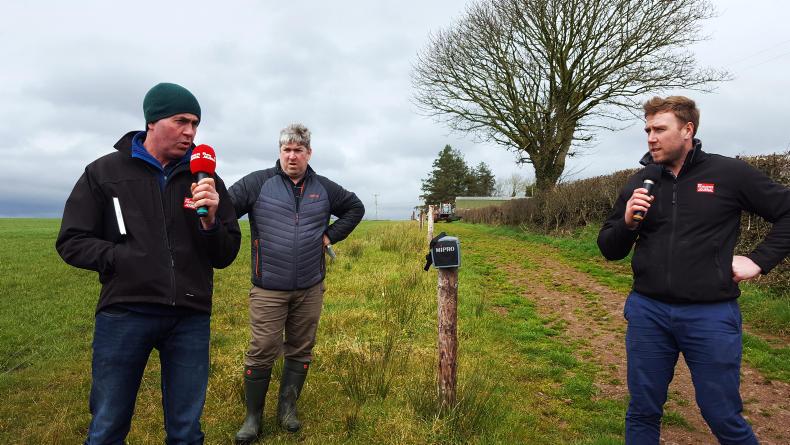Cows on Kevin McGrade’s farm near Dromore, Co Tyrone, are required to calve down in the autumn, go back in-calf easily and produce milk with high butterfat and protein.
Through selective breeding over the past 20 years, Kevin has developed a herd of robust cows that meet these criteria and are able to produce from grass in the spring and autumn when conditions allow grazing.
“We are batch-calving, so cows have to be fertile. We want one straw producing one calf with no bother,” Kevin told visitors to his farm on Tuesday.
Across the herd, body weights vary significantly from 430kg to 700kg and average weight currently stands at 570kg. The farm is in a high-rainfall area with mostly heavy clay soils so there is a focus on reducing the size of some of the bigger cows to limit damage to land at grazing.
Last year, the 146-cow herd averaged 6,600 litres/cow at 4.72% butterfat and 3.64% protein from 1,527kg concentrates. Cows are producing their weight in milk solids with average production in 2017 at 572kgMS/cow and calving index is 380 days.
Sample
During the farm walk, a sample of cows from the herd was used to highlight variation among individual cows. Cow 272 is more typical of the type of cow that the McGrades had in the early 2000s. She has a bodyweight of 612kg, started her fourth lactation on 26 January 2018, has a calving interval of 454 days and is currently yielding 40l.

Cow 174 has a calving interval of 362 days.Cow 174 has a calving interval of 362 days.
Last year, this cow yielded 8,990l at 3.41% butterfat and 3.13% protein. Under the NI milk pricing system, adjustments for milk quality meant cow 272’s milk was 0.61p/l below base price last year.
Kevin said that the main fault with cow 272 is fertility as she is calving outside his compact autumn-calving profile and is not producing a calf every year. “We won’t breed a replacement from this cow. She has good feet but her solids aren’t great and she will eat a lot more meal in our feed-to-yield system,” he said.

Cows 272 has a calving interval of 454 days.Cows 272 has a calving interval of 454 days.
This compares starkly with cow 174. This cow has a body weight of 437kg, started her fifth lactation on 11 September 2017, has a calving interval of 362 days and is currently yielding 24l.
Last lactation, cow 174 produced 6,143l at 5.12% butterfat and 3.89% protein allowing her component payment to be 4.40p/l above base price over the 2016-2017 season. This cow fits the bill for Kevin’s system in that she is extremely fertile and produces high-quality milk with a lower demand on concentrates.
“Before we started milk recording we would have bred from cow 272 because she looks like a nice cow. We don’t breed on looks now; decisions are based only on figures,” Kevin said.
The McGrades have been using high-EBI Holstein Friesian bulls for around 20 years and gradual improvement in the herd is a result of this breeding and not bought-in stock.

Cows have been housed full time for the past ten days with wet ground conditions.Cows have been housed full time for the past ten days with wet ground conditions.
Bulls used in the 2017/18 season have an average EBI of €258, with a sub -index for fertility of €127. The average production PTA (Predicted Transmitting Ability) for the group is 159kg for milk, 12kg for fat and 10kg for protein. Kevin also chooses sires based on low calving difficulty score, particularly with heifers, and he had no vet call outs for calving this year.
Change system
With the McGrade herd genetically geared to produce milk from grass, why not switch to a spring-calving system? Kevin says that autumn calving can lend itself better to managing heavier land and high rainfall. “We can have cows out at grass in February, but they can also be in during June if conditions are wet. We would end up with the same amount of feeding if we went spring calving,” he told visitors.

Pictured at the event are; host farmer Kevin McGrade, Dairylink Ireland advisor Conail Keown and Irish Farmers Journal dairy specialist Aidan Brennan.Pictured at the event are; host farmer Kevin McGrade, Dairylink Ireland advisor Conail Keown and Irish Farmers Journal dairy specialist Aidan Brennan.
Although the tight calving block has a high labour requirement at calving and breeding, Kevin said that it allows a simpler system of management.
“We are not calving cows and trying to detect heats at the same time. More cows are on heat at the same time which makes heat detection simpler too. Heifers are also a uniform bunch and so there are fewer groups of livestock on the farm, which is easier to manage,” he said.
Kevin also pointed out that compact calving has a knock-on effect on fertility as replacements are currently only kept from cows that went in-calf in the first seven weeks and all late calvers don’t breed replacements and eventually leave the system.

The herd is expanding and average cow numbers for 2018 could be around 160, with close to 180 cows potentially milking on the farm next year. His average replacement rate usually runs around 25% and expansion is coming from Kevin’s own stock as there are plenty of replacements coming forward with 66 maiden heifers and 56 heifer calves.
“If numbers weren’t increasing we could cull more severely. If we didn’t need extra cows we would sell all late calvers and not any surplus heifers,” Kevin told visitors.
The third farm walk being held on Dairylink Ireland project farms this spring takes place on Charles Clarke’s farm at Crocknahattina, Bailieborough, Co Cavan next Thursday (19 April). The event begins at 11am, concludes at 1pm and is free to attend.
Cows on Kevin McGrade’s farm near Dromore, Co Tyrone, are required to calve down in the autumn, go back in-calf easily and produce milk with high butterfat and protein.
Through selective breeding over the past 20 years, Kevin has developed a herd of robust cows that meet these criteria and are able to produce from grass in the spring and autumn when conditions allow grazing.
“We are batch-calving, so cows have to be fertile. We want one straw producing one calf with no bother,” Kevin told visitors to his farm on Tuesday.
Across the herd, body weights vary significantly from 430kg to 700kg and average weight currently stands at 570kg. The farm is in a high-rainfall area with mostly heavy clay soils so there is a focus on reducing the size of some of the bigger cows to limit damage to land at grazing.
Last year, the 146-cow herd averaged 6,600 litres/cow at 4.72% butterfat and 3.64% protein from 1,527kg concentrates. Cows are producing their weight in milk solids with average production in 2017 at 572kgMS/cow and calving index is 380 days.
Sample
During the farm walk, a sample of cows from the herd was used to highlight variation among individual cows. Cow 272 is more typical of the type of cow that the McGrades had in the early 2000s. She has a bodyweight of 612kg, started her fourth lactation on 26 January 2018, has a calving interval of 454 days and is currently yielding 40l.

Cow 174 has a calving interval of 362 days.Cow 174 has a calving interval of 362 days.
Last year, this cow yielded 8,990l at 3.41% butterfat and 3.13% protein. Under the NI milk pricing system, adjustments for milk quality meant cow 272’s milk was 0.61p/l below base price last year.
Kevin said that the main fault with cow 272 is fertility as she is calving outside his compact autumn-calving profile and is not producing a calf every year. “We won’t breed a replacement from this cow. She has good feet but her solids aren’t great and she will eat a lot more meal in our feed-to-yield system,” he said.

Cows 272 has a calving interval of 454 days.Cows 272 has a calving interval of 454 days.
This compares starkly with cow 174. This cow has a body weight of 437kg, started her fifth lactation on 11 September 2017, has a calving interval of 362 days and is currently yielding 24l.
Last lactation, cow 174 produced 6,143l at 5.12% butterfat and 3.89% protein allowing her component payment to be 4.40p/l above base price over the 2016-2017 season. This cow fits the bill for Kevin’s system in that she is extremely fertile and produces high-quality milk with a lower demand on concentrates.
“Before we started milk recording we would have bred from cow 272 because she looks like a nice cow. We don’t breed on looks now; decisions are based only on figures,” Kevin said.
The McGrades have been using high-EBI Holstein Friesian bulls for around 20 years and gradual improvement in the herd is a result of this breeding and not bought-in stock.

Cows have been housed full time for the past ten days with wet ground conditions.Cows have been housed full time for the past ten days with wet ground conditions.
Bulls used in the 2017/18 season have an average EBI of €258, with a sub -index for fertility of €127. The average production PTA (Predicted Transmitting Ability) for the group is 159kg for milk, 12kg for fat and 10kg for protein. Kevin also chooses sires based on low calving difficulty score, particularly with heifers, and he had no vet call outs for calving this year.
Change system
With the McGrade herd genetically geared to produce milk from grass, why not switch to a spring-calving system? Kevin says that autumn calving can lend itself better to managing heavier land and high rainfall. “We can have cows out at grass in February, but they can also be in during June if conditions are wet. We would end up with the same amount of feeding if we went spring calving,” he told visitors.

Pictured at the event are; host farmer Kevin McGrade, Dairylink Ireland advisor Conail Keown and Irish Farmers Journal dairy specialist Aidan Brennan.Pictured at the event are; host farmer Kevin McGrade, Dairylink Ireland advisor Conail Keown and Irish Farmers Journal dairy specialist Aidan Brennan.
Although the tight calving block has a high labour requirement at calving and breeding, Kevin said that it allows a simpler system of management.
“We are not calving cows and trying to detect heats at the same time. More cows are on heat at the same time which makes heat detection simpler too. Heifers are also a uniform bunch and so there are fewer groups of livestock on the farm, which is easier to manage,” he said.
Kevin also pointed out that compact calving has a knock-on effect on fertility as replacements are currently only kept from cows that went in-calf in the first seven weeks and all late calvers don’t breed replacements and eventually leave the system.

The herd is expanding and average cow numbers for 2018 could be around 160, with close to 180 cows potentially milking on the farm next year. His average replacement rate usually runs around 25% and expansion is coming from Kevin’s own stock as there are plenty of replacements coming forward with 66 maiden heifers and 56 heifer calves.
“If numbers weren’t increasing we could cull more severely. If we didn’t need extra cows we would sell all late calvers and not any surplus heifers,” Kevin told visitors.
The third farm walk being held on Dairylink Ireland project farms this spring takes place on Charles Clarke’s farm at Crocknahattina, Bailieborough, Co Cavan next Thursday (19 April). The event begins at 11am, concludes at 1pm and is free to attend. 










 This is a subscriber-only article
This is a subscriber-only article









SHARING OPTIONS: